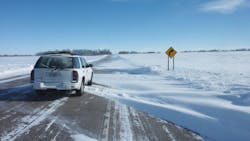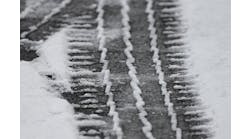According to the University of Minnesota, the topography and winter climate for a large portion of the Land of 10,000 Lakes causes the state to be particularly vulnerable to blowing and drifting snow on roadways.
This reality puts a particularly heavy burden on the state’s winter maintenance crews, who have to put in extra work clearing snow drifts to ensure the safety of the motoring public. This increases the costs of labor and equipment for the Minnesota Department of Transportation (MnDOT), which is seeking to minimize the impact of blowing and drifting snow on motorists by constructing snow fences.
These fences may come in a variety of forms, including a literal structural fence made of posts and rails, or a living snow fence composed of trees and shrubs. In whatever form it takes, the snow fence is designed to serve as a hindrance for blowing snow to reach the roadway.
Making a debut
MnDOT had the chance to try something new in order to protect a curved portion of SH 67 west of Granite Falls from blowing snow. This section of the highway runs diagonally northeast/southwest and is particularly prone to bursts of drifting snow, which MnDOT constantly had to clear.
“We’d have to call in people on off-hours just to plow this little stretch of road because the rest of the road would blow clean, but this area would drift shut,” Craig Gertsema, MnDOT District 8 Highway Maintenance Superintendent, told Roads & Bridges. “After one or two storms in the prevailing wind, we had to bring dozers and blowers, and clean out this area to prevent it from blowing shut every other day.”
For years, MnDOT had been seeking opportunities to partner with the landowners in the area in order to combat the vast amount of snow blowing around SH 67 to no avail. Success finally came when two residents, Aaron and Traci Fagen, bought the land along the troubled roadway after living there for some time. According to Gertsema, the couple approached a local MnDOT operator to discuss what could be done to reduce the impact of the blowing snow on the traveling public in the area. Their concerns were passed on to winter maintenance officials at MnDOT, who decided a structural snow fence would serve as an appropriate solution to curb the drifting snow along that stretch of the highway.
Hoping to seize the perfect opportunity to install the fence, MnDOT crews planned to set up the structure on the Fagens’ land just before the 2016-17 winter hit, following the fall harvest.
“We were looking to do the install before Thanksgiving—and then we got a snowstorm around Nov. 18 that prevented us from doing it before [then],” Dan Gullickson, snow control program administrative coordinator for MnDOT’s Office of Environmental Stewardship, told Roads & Bridges. “And once there was snow out in the field, it got real greasy, and we just couldn’t get equipment out there without mucking up [the] field and getting stuck. And then we just basically had to wait for winter [to] get a window of opportunity when the ground was frozen and we could traverse the land.”
Once the right equipment was on-site and concrete footings were set to anchor the structure, crews were able to install the fence in one working week. Sleeves were driven 7 ft into the ground to hold the fence up. The finished product rises 8 ft off the ground on the Fagen property and sits about 250 ft away from the road, stretching 1,500 ft across the land. MnDOT has a long-term rental agreement with the landowners to use their land as a home for the fence for 15 years. The terms of the agreement stipulate that MnDOT pays annual rent on the property for snow storage and maintains the fence in terms of tensioning rails and other needs on the structure itself. In return, the Fagens agreed to control the weeds underneath the fence.
While structural snow fences have been installed before on Minnesota lands, this one in the Granite Falls region remains unique for its design, as the landscape architects decided a woven fence, where the horizontal rails are set in a basket-weave pattern around the vertical posts, would give an aesthetic appeal to the structure.
“Their thought was if you could weave the horizontal rails, you provide an aesthetic component that could be a little softer and easier to look at on the landscape no matter what side of the fence you live on or have to look at,” Gullickson said. He added that the local MnDOT crews succeeded in applying the woven design after watching a standard structural fence installment and collaborating with architects and the fence manufacturer. As a result, history was made as the first known woven structural fence was installed in the state of Minnesota, as well as on North American soil, creating what Gullickson referred to as “a new standard.”
The curve along SH 67 in Minnesota is notorious for blowing shut on a regular basis in winter from vast amounts of drifting snow.
Structural vs. living
MnDOT has had the opportunity to partner with a number of farmers and landowners across the state to create snow fences for roadway protection. Sometimes, depending on the needs of the landowner, the department will work with them to create a living snow fence made of trees, shrubs, native grasses and wildflowers. When trying to maintain a smaller footprint on the land, a structural snow fence would do the trick. On the other hand, if landowners take an interest in creating a habitat to benefit wildlife species, a living snow fence would provide that need with the appropriate environment.
“The benefit of a structural snow fence is that it can work the first year we put it up. It’s already at the effective height,” Gullickson said. He added that a structural fence may work better in an agricultural setting with tile drainage systems. “The structural snow fence does not have a root system that can grow into a drain tile,” he said. “The other thing is in agricultural settings, herbicides are used for crop production, and some of these herbicides can be damaging to a living snow fence if they get drift on them.”
The smaller footprint that a structural fence leaves may work to the advantage of farmers as well. “One of the things I hear a lot is ‘I’m a farmer and I want to farm my land,’” Gertsema said. “This is an opportunity that, with this type of fence, to help maybe satisfy that need because we have a very small footprint with this fence versus the living snow fence.” The minimum width of a living snow fence is generally going to be 50 ft or more, whereas a structural fence is only about an 8-ft-wide footprint.
Another type of snow fence deployed in Minnesota includes standing corn rows, where farm operators may decide to leave standing cornstalks, bales or bags in winter until the following spring. “If corn’s being grown out there and it’s planted parallel to the highway, we have an opportunity to work with the landowner to leave some standing cornstalks in the field for snow control—whereas with a living snow fence or structural snow fence, it does take some time to engineer, plan and construct,” Gullickson said. “With standing corn rows, our plow operators have the opportunity to actually sign a farmer up for the coming winter.”
MnDOT had to wait for the winter of 2016-2017 to begin the snow fence installation, which took about a week to complete. The fence was put up 250 ft away from the road, and sleeves were driven 7 ft into the ground to hold up the structure.
Reaping the benefits
To determine how the structural snow fence near Granite Falls will benefit winter maintenance crews in the state, MnDOT officials did the math. The cost to install the fence was around $57,000 for materials and $30,000 for labor costs, bringing costs of installation close to $90,000. Over the span of 15 years, MnDOT crews will absorb minor maintenance requirements, such as tightening and adjusting the tension on the rails. Maintenance costs for the fence include just over $1,000 per year for the landowner to help with weed control underneath the fence.
These costs ended up being significantly less than what MnDOT estimated they would be spending on winter maintenance operations over 15 years without a snow fence in place.
“We could’ve potentially been spending $290,000 on that added equipment, getting dozers and blowers out there—and that’s just over a 15-year lifecycle,” Gullickson said. “We also estimate that we could reduce our salt tonnage used on this corner over 15 years by 126 tons.”
In addition to cost and labor savings, MnDOT’s Traffic Safety Office worked with the University of Minnesota on a research project back in 2011-12 to look at the safety benefits of snow fences. “We looked at where we have historically used snow fences along our highways, and where we made a difference in terms of improving safety,” Gullickson said. “And what they found in the study was, where snow fences were deployed—and it didn’t matter if it was structural, living or corn—but when they were deployed along a curve on the road, they found the crash severity was reduced by 40%.” Gullickson added that positioning the fence to protect the curve on the roadway at the Fagen property is a strategy that could help maintain safety for motorists.
Moving forward, MnDOT is continuing to rely on plow operators across the state to identify areas where snow fences or other winter-maintenance solutions beyond snow plowing may be needed. “That is something we really value—the experience of the plow operator who is out there during adverse weather conditions—getting their feedback and their input in terms of where they’re experiencing challenges, and how we might be able to better help them make their job easier,” Gullickson said. “But also helping improve the mobility of the traveling public that is using the highway.” The department has inventoried about 4,000 problem sites across the state with the help of their plow operators, equating to about 1,200+ miles of areas that require additional snow-control resources.
Another area MnDOT is trying to focus on is its relationship with farmers and landowners. Snow control representatives from the department recently attended Farmfest, an agricultural event in Minnesota attended by about 32,000 people. MnDOT saw this event as an opportunity to reach out to farmers to partner with on snow control operations through their standing corn row program or through a more long-term scenario with a structural or living snow fence.
For Gullickson, engaging private landowners is essential to the success of the snow fence program. “They’re giving up land that they’re potentially making their livelihood on, and we want to be good stewards and good neighbors with them,” he said. “So we need to find opportunities to better communicate, better connect with them so that we can establish that spirit of trust.”
Gullickson credits the MnDOT plow operators out in the field as being the most effective communicators with landowners. “They’re knowledgeable on what the problems are out there, so they can communicate that problem with the landowner,” he said. Oftentimes, plow operators are local to their community, which potentially makes it easier and more comfortable for landowners to talk with them about the snow control needs for the community. “Some of our best spokespeople about the program come from the plow truck.”


